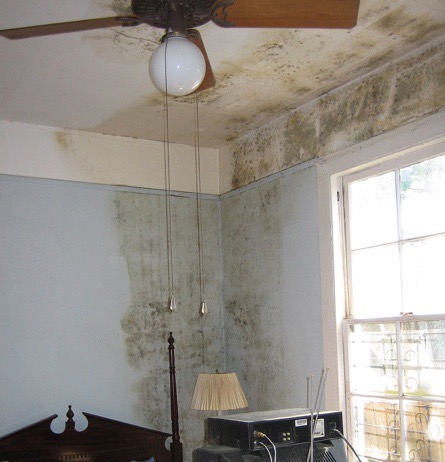

Mold can begin to grow inside a home or business for many different reasons. However, they all revolve around moisture. The fungus thrives in damp environments like kitchens and bathrooms. Hence, it can become part of the picture in these areas because of all the water and humidity. But, those aren’t the only place, oh no.
Mold can also become problematic in attics. This is especially true when roof leaks occur, or air conditioning units leak. Then again, a spraying plumbing pipe could be to blame
It is not uncommon for mold to flourish in closets and attics. Sometimes, symptoms are easy to spot. For instance, black, green, or other colored splotches might become apparent on walls or ceilings. On occasion, people can even smell mold growing. It will have a musty and unpleasant odor.
But there are also situations where no signs present themselves. Home or business owners could have mold hidden behind drywall, beneath wallpaper, or concealed elsewhere and not even know it.
About Flooding and Mold Growth
Often, mold can get inside a structure because of Mother Nature. For example, when storms like torrential downpours happen, streets and yards flood, as storm drains outside simply cannot keep up. Then, the water has nowhere to go and backs up into homes and businesses.
Anything and everything in its path gets soaked, including but not limited to furniture, electronics, and building materials like carpeting, drywall, and insulation.
When flooding occurs, moisture can get into even the smallest nooks and crannies. It remains hidden there because people miss it during the cleanup, and mold grows. Or maybe the individuals didn’t clean up fast enough, and the fungus seems to take over, growing on ceilings, walls, and everywhere in-between.
A/C Vents and Mold?
Yes, system failures and floods can leave your house or business full of mold. However, something doesn’t necessarily have to be wrong for mold to become a part of the equation.
Do you regularly run the A/C at your home or office? That’s a silly question. Of course, you do. How else would you and others stay comfortable when the sun is beating down?
Moisture can accumulate inside air conditioning ducts and create a suitable environment for mold to grow. It may show itself, appearing on your ceiling, wall, or floor duct covers. Then again, the fungus might stay hidden far back inside the ductwork.
Unfortunately, nothing will stay contained to a remote location, though. Mold spores will catch rides in the air traveling through the ducts and roam from room to room.
Experts suggest that households, on average, have their ducts cleaned every few years or so. Thus, if it has been longer than that, now is probably as good a time as any. But if recurring mold is a problem, your ducts will need to be cleaned more regularly. So, adjust your routine accordingly to keep fungus at bay.
Mold Should Not Be Left As-Is
Most individuals know that toxic mold can make people sick. That’s not the only type, though. All mold can cause humans to fall ill. Therefore, mold, regardless of the kind, should never be allowed to do as it pleases.
Symptoms of mold allergies vary, but some of the more common ones include sneezing, coughing/postnasal drip, and itchy eyes or throat. Meanwhile, mold can cause people with asthma to have asthma attacks too. When those occur, things like chest tightness, shortness of breath, and wheezing can come to be.
Mold Allergies
The majority of mold allergic reactions are hay fever-like. However, according to the Mayo Clinic, complications can arise from time to time. Severe allergic conditions include:
- Mold-induced asthma
- Allergic bronchopulmonary aspergillosis
- Hypersensitivity pneumonitis
- Allergic fungal sinusitis
We won’t get into explaining what all is involved with those here. If you’d like to learn more, visit www.mayoclinic.org. We are just making the point that you should take care of mold growth sooner rather than later, as there’s a chance the fungus could cause you, loved ones, employees, or customers to get sick.
DIY Mold Removal And Remediation Probably Isn’t The Way To Go
Some people probably think they can tackle mold removal and remediation on their own. To each their own, and that’s your prerogative if you want to go that route. You might be able to manage a minor mold problem of 10 square feet or less with a hardware store trip. But if the dilemma is worse, you might wind up biting off more than you can chew as well. It may turn out that what you thought you could handle with a bleach solution and household fans isn’t the case. Instead, the matter may be more complex, requiring equipment like air scrubbers and humidifiers.
Going it alone might lead to you leaving microscopic traces of the mold or mold spores behind. That would be horrible because you’d think you had gotten it all, only for people to fall ill later. Or what if you replace the drywall and the growth occurs again. That would be a waste of money, and no homeowner or business needs that. So, what should you do exactly? Rely on a professional mold removal and remediation company, of course.
When To Call In The Professionals For Mold Remediation
When to call in the professionals to remove and remediate mold is really up to you. However, here are some guidelines that may help you determine when to schedule an appointment.
If your home or office gets flooded and standing water sits in place for 24-hours or more, you should contact a mold remediation technician to assess the property. They’ll use established guidelines to examine everything and see what you’re dealing with.
Is there a musty smell you can’t quite pinpoint that’s driving you mad? This is another scenario where you should call in a professional.
